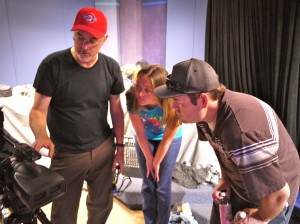Archive for the ‘3D Fundamentals & Craft’ Category
 3D MAY BE ALL BUT DEAD BUT THE CRAFT LESSONS OF 3D ARE NOT
3D MAY BE ALL BUT DEAD BUT THE CRAFT LESSONS OF 3D ARE NOT
Its most recent demise has been nothing short of astonishing. As recently as four years ago 3D seemed atop of the world and gaining momentum with filmmakers and TV broadcasters around the world seemingly poised to jump on the 3D bandwagon. Pouring tens of millions of dollars into new cameras, rigs, and displays, the major manufacturers like Sony and Panasonic subsidized to a huge extent startup venues like Sky 3D and Direct TV’s Channel 101. By January 2013 virtually every large screen display sold in the USA offered a 3D capability.
Then what happened? Despite the manufacturers’ best efforts and massive financial investment the public in Western countries never really cared for 3D. In Asia the public’s view was more positive but the interaxial handwriting was already on the wall in the principal markets in the USA and Europe.
Today, save for the few studio tentpole movies still distributed in 3D, the format has become all but irrelevant for most non-theatrical applications. You can blame it on the uncomfortable glasses, the underpowered insufficiently bright displays, or the poorly developed skills of 3D filmmakers, who not understanding the physiological impact of stereo viewing, unwisely opted for maximize depth at the price of viewer comfort. It goes without saying that inflicting riveting pain on one’s audience is not a good way to win its loyalty and affection!
Since the dawn of painting and photography the challenge to artiss has always been how to best represent the 3D world in a 2D medium. Because the world we live in has depth and dimension, our filmic universe is usually expected to reflect this quality by presenting the most life-like three-dimensional illusion possible for our screen characters to live, breathe and operate most transparently.
In the 2D world of cinema and TV the camera craftsman uses mainly texture and perspective to foster the desired three-dimensional illusion. While the 3D shooter makes use of many of the same tools the stereo format inherently goes a long way to promote the feeling of a real world experience. In fact the 3D shooter must often mitigate the use of aggressive depth cues, as the forcing of perspective can be very painful to viewers.
As a cinematographer and 3D specialist I attribute the format’s lack of public acceptance to something rather fundamental. Of course the ‘3D’ format isn’t really 3D at all but stereo, which is much less immersive. Viewing a movie or TV broadcast in stereo requires substantial viewer effort, a reliance on a gimmick or ‘loophole’ in human physiology that allows viewers to separate focus from convergence. As it turns out a large part of the audience is simply unable or unwilling to perform the unnatural act of forming a 3D image in its mind; it can be tiring or painful, and not at all conducive to what is supposed to be an entertaining experience.
In spite of all this, the savvy cameraperson today understands that the lessons of 3D, i.e. communicating the maximum number of depth cues to viewers, can greatly enhance the impact, breadth, and effectiveness, of our traditionally composed 2D captured scenes.
 VIDEO SHOOTER 3rd Edition Now Available!
VIDEO SHOOTER 3rd Edition Now Available!
It’s finally here! With lots of new and updated material, including discussion questions for educators and in-depth chapters on the DSLR and 3D shooting and storytelling.
http://www.amazon.com/Video-Shooter-Mastering-Storytelling-Techniques/dp/0240825179/ref=sr_1_1?s=books&ie=UTF8&qid=1386742775&sr=1-1&keywords=video+shooter
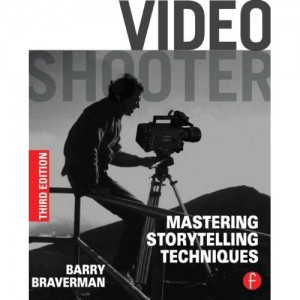
 3D Training in the UK
3D Training in the UK
The moribund state of 3D has left manufacturers and broadcasters in a state of bewilderment and deep despair. Yet if I’m correct this is about to change in a BIG way with the arrival next year of 3D tablets and mobile phones. The advent of huge numbers of these devices will usher in a vibrant new 3D era, this time driven by non-theatrical applications, from sports and music videos, to remote education, corporate, and medical research.
This week I am in London leading a 3D Camera & Storytelling Workshop for young cinematographers, producers, and directors, at the National Film and Television School. It is a testament to the school to recognize that students must possess fundamental stereo skills in the media world of the very near future.
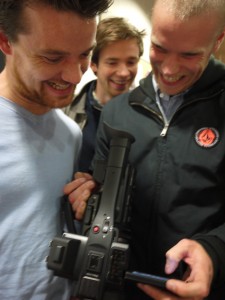
3D Education at the National Film and Television School London • 29 October 2012
 The Right Interaxial For You
The Right Interaxial For You
It’s not a stupid question. Consider the major strength and weakness of the Panasonic 3DA1 is its orthostereoscopic 60mm interaxial. On the one hand by matching a human being’s interocular distance, we can be assured that objects captured at a “normal” distance with a “normal” lens will appear with a “normal” roundness from a human being’s perspective. This is critical if we as shooters are to be successful in our 3D endeavors: capturing your leading lady or young starlet with her head shaped like a medicine ball will not do much for your career.
On the other hand the 60mm interaxial can be limiting; objects approaching well inside of ten feet (3m) may cause severe eye strain; the hyperconvergence inducing headaches, nausea and a flight to the exits. This is because the converging of the eyes requires musular effort, which increases dramatically with diminishing object distance. A similar peril exists on the other side of the screen in positive space. The 60mm IA increases the risk of hyperconvergence; a condition audiences particularly loathe as they try to splay their eyes out like Marty Feldman.
Panasonic’s new 3D camcorder HDC-Z10000 effectively reduces the risk of hyperconvergent and hyperdivergent conditions. By shrinking the interaxial to 42mm the economical 3D model ($3500 list) will allow comfortable capture of objects down to a mere 17 inches (45cm). This means the Z10000 will prove more useful in the critical six to eight foot (1.5m – 2.5m) range where we shooters tend to do most of our work.
The down side of the narrower IA is the noticeable loss of depth beyond fifteen feet (4.5m). This may be fine if working primarily on sets or for shooting sit-down intereviews when coupled with the wider than normal (32mm equivalent) lens. This is a critical point. Shooting with the Z10000 and a “normal” lens will yield the approximate point of view of a small dog or cat whose interocular distance is 42mm. Maybe this is what you want, maybe it isn’t. The point is to know what the heck you are doing: The narrow IA decreases roundness from a human perspective; the wider field of view gained from the 32mm equivalent lens increases roundness to restore the human perspective.
The design of the Z10000 with its lofty ridiculous model number is designed to do exactly that.
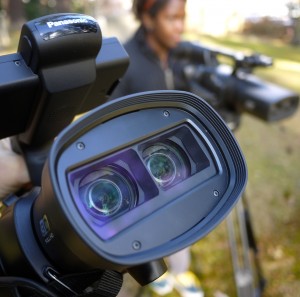
Panasonic's Z10000's 42mm interaxial allows comfortable close placement of objects as close as 17 inches (45cm) but beware the loss of the human perspective; we see the world with our eyes about 65mm apart and so our 3D camera and storytelling skills must be adjusted to ensure capturing objects with the proper desired roundness.
 The French are Going 3D – Even If Others Aren’t
The French are Going 3D – Even If Others Aren’t
In a recent poll about 80% of Americans were said to hold a negative view of 3D entertainment movies and TV. With such a predisposition towards 3D it’s not surprising that 3DTV should find very tough going in North America. In Southeast Asia, the 80% figure also applies, except there the lop-sided percentage refers to positive feelings towards three-dimensional format; only 20% of consumers of theatrical fare have a somewhat or very negative view of 3D.
In Europe the feelings are not quite so negative towards 3D entertainment, especially in France, where the bulk of 3D equipment sales, cameras and plasma displays have taken place. I am in the UK this week, and I can perceive a substantial level of resistance from consumers, albeit at not nearly the level of disinterest or even antipathy that is currently the case in the U.S.
Maybe France knows something the rest of the West doesn’t. Or else it may simply be reflective more of French culture and proclivities in the cinema.
 Seeing Red in 3D Quality Control
Seeing Red in 3D Quality Control
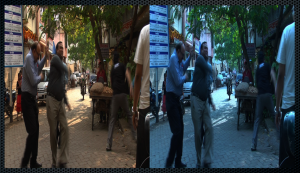
Comfortable 3D viewing requires matching left and right eye photography. The QC session can help identify obvious faults.
I recently spent a morning at Technicolor’s 3D quality control lab in Glendale CA and was extremely impressed with the sophistication of the QC teams and the review process. Graphical software developed by Technicolor enables the QC operator to accurately assess hyper-divergent and hyper-convergent scenes. No remedial action is performed at this point; the process is solely intended for informational purposes, to alert the filmmaker of potential problems that might impact the viewer’s comfort and overall experience.
Only four pixels of vertical disparity will pass muster in the QC suite so left and right cameras with even the slightest mismatched geometry are readily identified. Color discrapancies and synchronization issues affecting the left and right eye are also easily spotted and flagged. Truth is, under this level of scrutiny, virtually every 3D project ever produced, regardless of budget, will return a bevy of red trouble flags.
The filmmaker’s challenge then is to somehow separate the redness of the QC report from his or her legitimate storytelling goals. The creative requirements of visual storytelling in the third dimension necessarily precludes following too closely the dicates of the QC session. Producers may look upon the report’s red areas, a hyperdiverged background, for instance, in the corner of a scene, and lambaste the stereographer, director and DP, but is this “fault” so identified in the QC report really a defect that will detract from the viewing experience?
Let’s keep in mind that story above all must drive the technology, not the other way around. Audiences do not determine their like or dislike for a 3D program based on the green versus red ratio in a QC report. Yes, the report can be extremely useful to identify clearly disturbing 3D conditions, but it should serve as gospel to compel changes in the storytellers’ creative choices.
 Spreading the Wealth of 3D Knowledge
Spreading the Wealth of 3D Knowledge
It isn’t too often that I am able to offer a 3D camera workshop at a local community college. And this is a pity, for too often we teachers of the video storytelling craft are overly consumed with the name-brand schools, you know, the high-profile institutions that garner most of the headlines and prestige. You can blame the camera manufacturers for much of this; the prospect of significant sales in these wealthy institutions being foremost in their minds.
Still, we trainers are also partly to blame for not doing quite enough to better advertise our wealth of knowledge and enthusiasm. My June 3D workshops at Palomar College in San Marcos CA convinced me that 3D production can be just as relevant and motivational to students at more modest educational institutions. Without exception my Palomar students demonstrated the utmost willingness to take the risks necessary to excel in the new and exciting 3D arena.
To be clear we’re not necessarily talking about aspiring feature filmmakers here. Indeed I am convinced the future of 3D will be predominantly in the non-theatrical arena – in corporate, industrial, wedding and events, and education.
Thus the importance of 3D evangelists and instructors around the world to reach out to all students regardless of economic standing. The skills and confidence gained from the 3D workshop will serve them well, as the jobs and projects of the future will increasingly require an understanding of stereo principals for efficient image capture and post-production.
I welcome the opportunity to offer my knowledge and training to a wide cross section of students all over the world. As I write this I am en route to Tanzania to lead a camera workshop next week at the Zanzibar International Film Festival . While my students will no doubt learn a wide range of skills to enhance their visual storytelling I also know that I will receive far greater inspiration in return; these East African filmmakers and camera people serving up their own remarkable stories reflecting their unique experiences and insights.
http://www.ziff.or.tz/news/high-definition-workshop-barry-braverman-ziff
 Engineers & Post Wonks: Take a Hike!
Engineers & Post Wonks: Take a Hike!
This month I had the opportunity to lead a two-day Panasonic/DirecTV-sponsored workshop in connection with a national 3D student movie making contest. I also led a longer (five-day) student workshop in Mumbai in February that was vastly different in tone and scope. The Indian sessions featured almost three days of teaching story development skills, a critical training component invariably omitted by the overzealous technical wonks.
I’ve been saying for years that we trainers of the video craft place far too much emphasis on the technical minutiae and too little on story and the emotional component, which are after all the only thing an audience truly cares about. Unfortunately the tech heads raised their ugly heads once again in the three days ahead of my Los Angeles workshps at DirecTV. An “expert” from one of Hollywood’s foremost tech houses had apparently urged may students to adopt the so-called French system of shooting 3D, known as Le Méthode Dérobé.
The method stipulates that the background divergence of a scene must be fixed at the maximum percentage specified by the broadcaster, and that we should only vary the camera’s interaxial distance to set the desired convergence angle. Since the Panasonic AG-3DA1 has a fixed IA of 60mm, this means, according to this expert, that the camera must be placed at precisely 9.5 feet (about 3m) to avoid unacceptable hyper-divergence.
As my students struggled through their storyboards, it was obvious that maintaining a fixed 9.5 foot camera distance was impractical, that adopting such a restrictive approach would severely detract from the effectiveness of the students’ visual stories.
The fact is, given the limitations of the camera’s fixed IA, the 3DA1 shooter must be mindful of potential hyper-divergence, too close objects, the impact of focal length on object roundness, and, of course, the intended size of the 3D display screen. These matters are integral to shooting 3D in any form, but are especially critical when shooting with the 3DA1, given the inherent limitations of a fixed binocular-lens system.
 India Gets It Right
India Gets It Right
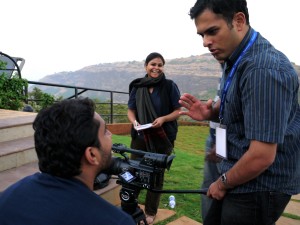
The Panasonic 3DA1 one-piece camcorder is an excellent tool for teaching effective 3D storytelling skills.
I’m back in India now conducting another in a series of 3D camera workshops featuring the Panasonic 3DA1. This time I am training TV and cinema students from around the country participating in a 3D Movie Making Contest.
Unlike other 3D workshops, this one is focusing not so much on the camera per se, but rather on the art and craft of 3D filmmaking. This is what we ought to focus all of our camera workshops: on story, story, story. After all as Sidney Lumet so aptly said (more or less) story is the conduit through which all creative and technical decisions flow.
So the rudiments of good story and good camera craft must necessarily go hand-in hand. This four-day workshop being conducted two hours out of Mumbai is looking at 3D storytelling as a craft onto itself, with the details of camera, workflow and concomitant skills coming into play only so much to fulfill one’s storytelling goals.
The compact integrated 3D camcorder fits beautifully into this enlightened mindset, as the simplicity of the tool allows much greater emphasis on what really matters to audiences.
In the future I’m hoping to pursue more workshops like this one, where the demands of story come first, and the technical details (as important as they may be) assume their proper supporting role.
 What do the Indians know?
What do the Indians know?
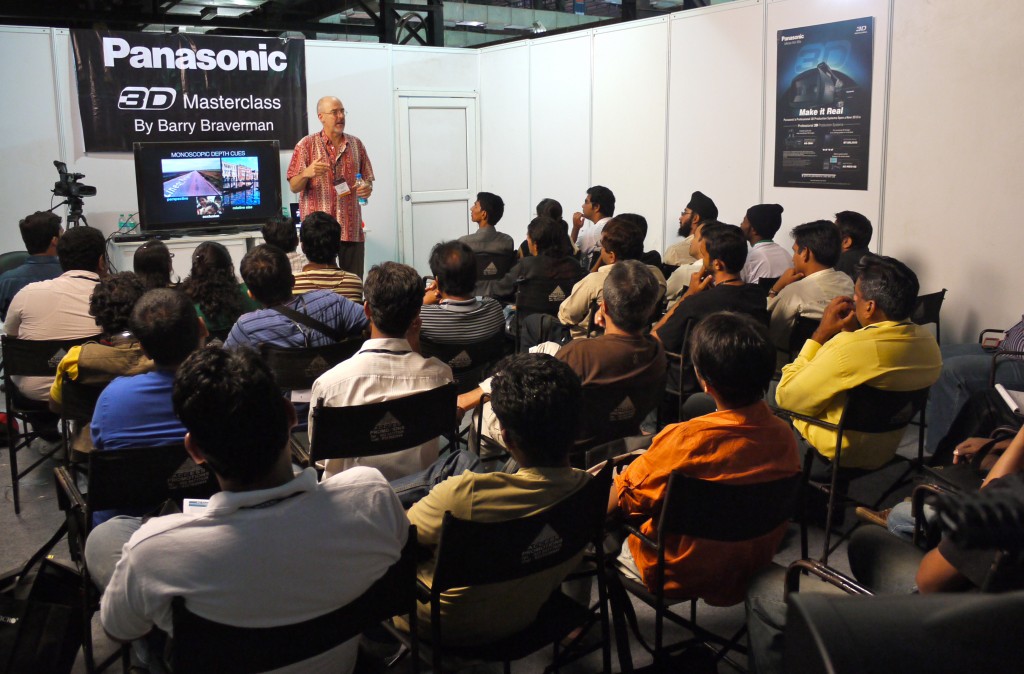 I’ve been in Mumbai for several weeks teaching 3D camera skills to eager Indian filmmakers. It makes sense to me that 3D should find a welcome home here. After all the Bollywood sensibility of four-hour epics with abundant song and dance numbers lends itself perfectly to the 3D format. Unlike most of the rest of the world the cinema is alive and flourishing on the subcontinent, with regular movie attendance continuing to grow each year. It stands to reason therefore that those of us who love cinema should pay increased attention to what used to be strictly Indian fare. The finest technicians in the world are practicing and perfecting their craft daily here. Where are the filmmakers in the rest of the world honing their skills now? There are simply too few large-scale productions elsewhere to produce highly proficient shooters and storytellers. Is this the result of the “democratization” of the digital medium we’ve heard so much about?
I’ve been in Mumbai for several weeks teaching 3D camera skills to eager Indian filmmakers. It makes sense to me that 3D should find a welcome home here. After all the Bollywood sensibility of four-hour epics with abundant song and dance numbers lends itself perfectly to the 3D format. Unlike most of the rest of the world the cinema is alive and flourishing on the subcontinent, with regular movie attendance continuing to grow each year. It stands to reason therefore that those of us who love cinema should pay increased attention to what used to be strictly Indian fare. The finest technicians in the world are practicing and perfecting their craft daily here. Where are the filmmakers in the rest of the world honing their skills now? There are simply too few large-scale productions elsewhere to produce highly proficient shooters and storytellers. Is this the result of the “democratization” of the digital medium we’ve heard so much about?
